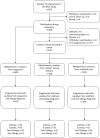Associations of maternal and infant metabolomes with immune maturation and allergy development at 12 months in the Swedish NICE-cohort
- PMID: 34135462
- PMCID: PMC8209090
- DOI: 10.1038/s41598-021-92239-3
Associations of maternal and infant metabolomes with immune maturation and allergy development at 12 months in the Swedish NICE-cohort
Abstract
Allergic diseases are the most common chronic diseases in childrenin the Western world, but little is know about what factors influence immune maturation and allergy development. We therefore aimed to associate infant and maternal metabolomes to T- and B-cell subpopulations and allergy diagnosis. We performed liquid chromatography-mass spectrometry based untargeted metabolomics on blood plasma from mothers (third trimester, n = 605; delivery, n = 558) and from the umbilical cord (n = 366). The measured metabolomes were associated to T- and B-cell subpopulations up to 4 months after delivery and to doctor´s diagnosed eczema, food allergy and asthma at one year of age using random forest analysis. Maternal and cord plasma at delivery could predict the number of CD24+CD38low memory B-cells (p = 0.033, n = 26 and p = 0.009, n = 22), but future allergy status could not be distinguished from any of the three measured metabolomes. Replication of previous literature findings showed hypoxanthine to be upregulated in the umbilical cord of children with subsequent asthma. This exploratory study suggests foetal immune programming occuring during pregnancy as the metabolomic profiles of mothers and infants at delivery related to infants' B-cell maturation.
Conflict of interest statement
The authors declare no competing interests.
Figures
Similar articles
-
Associations of the placental metabolome with immune maturation up to one year of age in the Swedish NICE-cohort.Metabolomics. 2024 Feb 26;20(2):28. doi: 10.1007/s11306-024-02092-4. Metabolomics. 2024. PMID: 38407648 Free PMC article.
-
Umbilical cord blood metabolome differs in relation to delivery mode, birth order and sex, maternal diet and possibly future allergy development in rural children.PLoS One. 2021 Jan 25;16(1):e0242978. doi: 10.1371/journal.pone.0242978. eCollection 2021. PLoS One. 2021. PMID: 33493154 Free PMC article.
-
Cord Blood Levels of EPA, a Marker of Fish Intake, Correlate with Infants' T- and B-Lymphocyte Phenotypes and Risk for Allergic Disease.Nutrients. 2020 Sep 30;12(10):3000. doi: 10.3390/nu12103000. Nutrients. 2020. PMID: 33007868 Free PMC article.
-
Prevention of allergic disease in childhood: clinical and epidemiological aspects of primary and secondary allergy prevention.Pediatr Allergy Immunol. 2004 Jun;15 Suppl 16:4-5, 9-32. doi: 10.1111/j.1399-3038.2004.0148b.x. Pediatr Allergy Immunol. 2004. PMID: 15125698 Review.
-
Role of regulatory dendritic cells in allergy and asthma.Curr Allergy Asthma Rep. 2005 Jan;5(1):56-61. doi: 10.1007/s11882-005-0055-3. Curr Allergy Asthma Rep. 2005. PMID: 15659264 Review.
Cited by
-
Multi-omics profiling approach in food allergy.World Allergy Organ J. 2023 May 15;16(5):100777. doi: 10.1016/j.waojou.2023.100777. eCollection 2023 May. World Allergy Organ J. 2023. PMID: 37214173 Free PMC article. Review.
-
Biomarker Candidates of Habitual Food Intake in a Swedish Cohort of Pregnant and Lactating Women and Their Infants.Metabolites. 2024 Apr 29;14(5):256. doi: 10.3390/metabo14050256. Metabolites. 2024. PMID: 38786733 Free PMC article.
-
Associations of the placental metabolome with immune maturation up to one year of age in the Swedish NICE-cohort.Metabolomics. 2024 Feb 26;20(2):28. doi: 10.1007/s11306-024-02092-4. Metabolomics. 2024. PMID: 38407648 Free PMC article.
-
The impact of the gut microbiota on T cell ontogeny in the thymus.Cell Mol Life Sci. 2022 Apr 4;79(4):221. doi: 10.1007/s00018-022-04252-y. Cell Mol Life Sci. 2022. PMID: 35377005 Free PMC article. Review.
-
Disrupted fetal carbohydrate metabolism in children with autism spectrum disorder.J Neurodev Disord. 2025 Mar 29;17(1):16. doi: 10.1186/s11689-025-09601-z. J Neurodev Disord. 2025. PMID: 40158086 Free PMC article.
References
Publication types
MeSH terms
LinkOut - more resources
Full Text Sources
Medical
Research Materials



